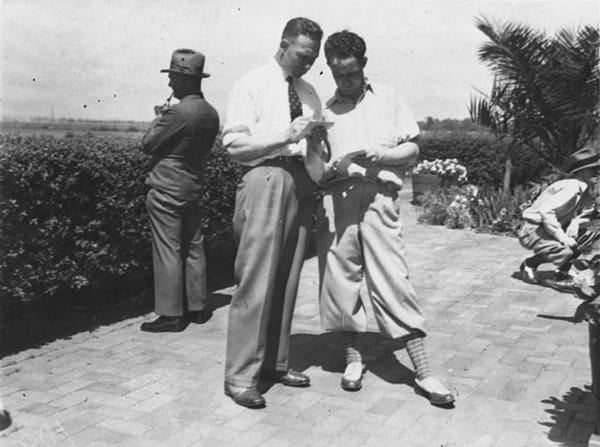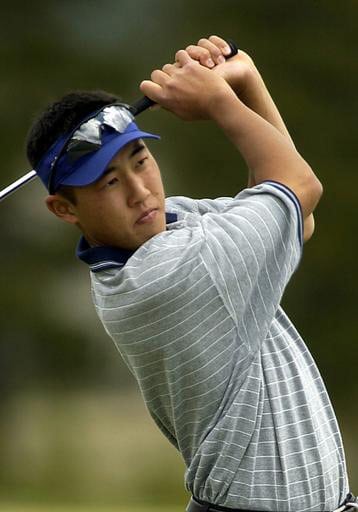A Texas scrample is a golf format that typically involves a team of 4 players. Every player tees off and then the “best” ball is chosen (or in other words the ball in the “best” position). This ball is marked and then all players then play their next shot from this position (after picking up their ball). The play continues in this way on every shot until the ball has entered the hole.

This format is normally played with many teams of 4 taking part. Typically up to 18 teams may take part, with 1 team on every hole. Although, it’s not uncommon for more teams than this to play a texas scramble. The winning team is the one with the lowest overall score.
The terms “scramble” and “Texas scramble” are often used interchangeably. But technically, there is a slight difference, since a Texas scramble is a variation of the regular scramble.
With a Texas scramble, each player is required to play at least 4 drives per round (for a team of 4). In a regular scramble there is no such requirement. In theory, 1 player could take every single drive throughout the round.

One advantage to the regular scramble is that the gameplay tends to be quicker, since the “best” tee shot is chosen each time. Whereas in a Texas scramble, more discussion is generally involved since the players need to consider how many drives each player still requires. Additionally, a regular scramble tends to be more enjoyable for weaker players since they don’t have much pressure on their tee shots.
However, in my view the Texas scramble is the superior format. There is more strategy and tactics involved which I believe makes for a more interesting game. The requirement for 4 drives each also helps to balance the game somewhat. It makes it much harder for 1 good player (a good driver of the ball) to “carry” a team.
A scramble in golf is often called “captain’s choice”. This is because usually each team nominates a captain. The captain is responsible for chosing the “best” shot, hence the name “captains choice”.
Although many people believe the name refers to the captain of the club, this is not the case. It simply refers to the captain of each team.

However, it is not necessary to have a captain, some teams choose to make a group decision on each shot. But it’s probably a good idea to nominate a captain prior to the round. A captain can make tough/split decisions, as well as helping to prevent arguments!
A shamble is quite an uncommon format which is somewhat different from a scramble. In a shamble, each player tees off and the best tee shot is selected. Each player then plays from this position, just as in a scramble. However, this is where things change.
From then on, each player plays their own ball, with all 4 scores to count on each hole (for a team of 4). Since each player is required to hole out, a shamble is generally suited to more skilled players.

This is probably the reason why the shamble is a rarely played format. In stark contrast to the texas scramble, there is pressure on every player in the team to make a good score.
Bear in mind that there are no official rules for texas scramble and it is considered more of a “fun event” as opposed to a serious competition. Given that’s the case, rules can vary quite significantly from club to club. This is generally seen as one of the problems with the format, with teams within the same competition often playing to different rules!

Always be sure to check the rules with the tournament organisers before teeing off.
That being said, I’ll go over some of the commonly used rules in this section.
Texas scramble organisers can adopt for either dropping or placing to be used as follows:
In my experience of playing texas scramble in the UK, I have found that common practice is to mark the selected ball within 6 inches. Then, place within 6 inches when on the fairway or drop within 1 club length in the rough.

I’ve never heard of placing in the rough (or anywhere other than the fairway/green) but I’m sure it’s played by some clubs.
This may go without saying but placing is always allowed on the green, even if the rules say to drop on the fairway.
In my view, placing is the best ruling to use for a couple of reasons. Firstly, a Texas scramble is supposed to be a fun game for all skill levels so why make it harder? Secondly, Texas scrambles can be quite a slow format so to me, it makes sense to speed things up where possible.
A 2 man texas scramble is just like a regular 4 man texas scramble but with only 2 players. At the start of each hole, both players hit their tee shots. The “best” ball is chosen, marked, and both players then play from that shot. The next “best” ball is marked and play continues in this way until the ball has been holed.
Best ball, or “better ball” is a 2 player team format which is often confused with 2 man texas scramble. In best ball, each player plays all their own shots as normal. At the end of each hole, the lowest score of the 2 players is recorded.

Best ball is a popular format which is played in the Ryder Cup, where it is known as “foursomes”. Where Texas Scramble tends to be considered a “fun” format, best ball tends to be regarded as more of a “serious” format.
In a Florida scramble, everyone tees off just like in a Texas Scramble. The “best” ball is then chosen but after that, the player who played the “best” shot is not allowed to play the next shot (but they can rejoin afterwards). The play continues in this way until the ball is holed out.

The advantage to the Florida scramble is twofold. Firstly, the format tries to balance the contributions of the team members. In a texas scramble, 1 player could play every shot on a hole. This is not possible in a Florida scramble, where the shots are often spread out more evenly among the team players.
Secondly, since there’s one less player taking each shot (except for the drive), the game tends to be speeded up. Many people find the Texas scramble too slow so this is usually a welcome feature.
One of the biggest disadvantages to the format, is the simple fact that 1 player has to sit out on each shot. Some players don’t mind this but for others it can be frustrating.
You may have heard of a Mexican scramble in golf. This is similar to a Texas scramble but has a key difference when it comes to the selection of shots. Before the round, each player is designated a number from 1-4.
Every player then tees off, just like in a Texas scramble. But instead of picking the “best” ball, a dice is rolled to determine which ball to take. When 6 sided dice are used, the team captain keeps rolling until a number from 1-4 is rolled. The player with the corresponding number is selected and their shot is used.
From there on, the gameplay continues in just the same way as a Texas scramble. The dice are only rolled to chose the drive, and not on any other shot.

The Mexican scramble can be quite a fun format as the team is often required to play from a poor shot. This can be especially amusing when someone has hit a great drive but the team is forced to use a poor drive. But it is also rewarding when that great drive is selected.
This format can help to even out the play a little, with teams not being able to capitalise from 1 player’s good shots as frequently. However, it can be a challenging format, especially for weaker or newer players. This is probably why it isn’t seen very often.
A Champagne scramble is generally only played as a team of 4. It is considered by many to be the best form of scramble, hence the name.
In a Champagne scramble, every player in the team tees off and the “best” drive is selected, just as with a normal scramble. But from the second shot onwards, each player plays their own ball until they have holed out. The best 2 scores on each hole are to count. The stableford scoring system is often used in this format to make it somewhat more forgiving.
The Champagne scramble is similar to a shamble but only 2 player’s scores are to count instead of all 4. This makes the format quite a bit more forgiving.

I think one of the main reasons why this format is well loved is because it plays faster than a Texas scramble. The selection process only occurs on the drive and then after that play continues as normal. Many people also prefer playing their own ball, as opposed to stopping and resetting on every shot.
Probably the main downside to the Champagne scramble is that it isn’t as forgiving to lower skilled or weaker players (although it is more forgiving than a shamble). This is perhaps why it isn’t played very often. In contrast, a Texas scramble is an accessible format for virtually every skill level.
Handicaps do count in a Texas scramble. As with more common golf formats, this helps to even out the competition. Many different handicap systems are used for Texas scrambles so be sure to find out the specific rules before playing in one.

Keep reading to the bottom of this article to find out how to calculate the handicaps in a Texas scramble. But now, I’m going to go onto what everyone wants to know, how to win at Texas scramble!
To win a Texas scramble, everyone on the team needs to work together. Ideally, when the team is having a bad hole, you need someone to rescue it with a good shot or 2! And when the team is having a good hole, you need to hole the putt to make the most of it.
Obviously this is not really something you can plan for, but there are some strategies which can massively help. I’ve put together a collection of tips in this section which should help.

Texas scrambles can be very unpredictable, with so many ways to make a good score. There’s a saying that goes like this:
“In a Texas Scramble, it’s not how well your team plays, it’s how well you play together.”
However, winning a Texas scramble is not easy, even if everyone in your team plays well. You may be suprised at some of the scores that other teams have!
As a general rule of thumb, the winning score for a Texas scramble tends to be between 10 under and 18 under. That’s right, -10 to -18! That may seem very low but remember there are a lot more opportunities to score in a Texas scramble.
During the round, it’s probably good to have an idea of how you’re scoring. That way, if you’re way off the pace then you know you can be more aggressive. Bear in mind though that if you’re team is struggling with tough conditions, there’s a decent chance everyone else is too.

These figures are also with handicaps taken into account. But I’ll tell you a story about the lowest score my team made in a texas scramble once.
I was playing in a 4 man team of low handicappers. I think I was the highest handicap at 3! Anyway, we all played well and we shot 18 under gross! That’s -18 before the handicap allowance (not that it was much). There were only 2 holes that we didn’t birdie. One of them we made an eagle, and on the other one I holed a 40ft putt for par on the 16th hole. That one felt like an eagle too!
So here’s the bit you’ve been waiting for, how to score well in a texas scramble. There are quite a few strategies and tactics below that have helped me over the years.
Getting a ball in play early takes a bit of pressure off the rest of the players. Additionally, it allows the other players to be more aggressive, knowing that one ball is already safe.

This is especially important off the tee but also on other approach shots and lay ups. The only time you may consider saving the more accurate player is if they are the best player (see the next section).
In general, you want the biggest hitter to go last off the tee. This way then can assess whether it is worth taking a risk by going for a long drive. If another ball is already in a decent position then it may well be worth going for a riskier shot.
Additionally, the biggest hitter is often the best player. Usually this means they will be able to deal with the pressure better. For example, in the case where there isn’t a good shot in play and they’re last to go. In contrast, leaving the lower skilled players to go last is generally the worst idea as they tend to be less comfortable with pressure.
Another point to consider is that a better player will learn more from the other player’s shots. For example, let’s say the team is playing an approach shot. A good player can learn about the strength and direction of the wind or the firmness of the green from the previous player’s shots.

Learning from previous shots is even more important when on the green. This brings me onto my next point.
The best putter should always play last. They can gather key information about the line and speed of the putt as the other players are putting.
Also, there’s nothing stopping them from standing directly behind the line of the putt as each shot is played. In fact, at least 1 player should be doing this every time. Making putts is absolutely key in texas scramble when you have so many opportunities to make them. Be sure to gather as much info as you can from each putt.

It’s also a good idea for everyone to make sure they reach the hole. In a texas scramble it’s basically impossible to 3 putt. And of course, there’s no chance of the ball going in if it doesn’t reach. Aggression is key in a texas scramble, you must take advantage of the number of chances you get.
Remember that in a Texas scramble, the team must use at least 4 drives from each player (for a team of 4). If possible, it’s a good idea to get everyone’s drives in before the last few holes. Otherwise it could spell disaster!
Also, you may want to think about the types of hole that suit each player. For shorter hitters, ideally you want to use their drives on the shorter holes. This could mean that on some holes you don’t take the best drive.

For the longer hitters, you should ideally be using their drives on the longer holes in order to take advantage of the length. The exception to this rule is if a long hitter drives a short par 4. In that case you could have a tricky decision to make.
The final and perhaps most important tip is to be aggressive! With so many opportunities to score well, you need to take them. If your team doesn’t, another team will, so don’t be afraid to take some risks.

And as mentioned previously, don’t forget to be aggressive with the putter. If the ball doesn’t reach the hole, it doesn’t go in! Or as the old saying goes:
“Never up never in!”
Finally, remember the Texas scramble is supposed to be a fun format. Enjoy the game and try to help each other. Some of my most memorable golfing memories have been made while playing in a Texas scramble.

Now you have an idea of how to play a Texas scramble, let’s go over how the handicaps work.
Below I’ll go over some of the main ways in which the handicaps are calculated.
One of the oldest and most common handicap allowances for texas scramble is described below. There is one calculation for teams of 4 and another for teams of 3. It is worth noting that there are also many variations of this “old” handicap system for texas scramble.
For teams of 4, the handicap allowance is calculated as follows:
Eg. the calculation for a team with respective handicaps of 7,15, 21, and 26 is as follows:
This team would therefore have a handicap of 7 strokes (rounded up), which would be subtracted from their total score at the end of 18 holes.
For teams of 3, the following calculation is used:
Eg. the calculation for a team with respective handicaps of 7,14, and 22 is as follows:
This team would therefore have a handicap of 9 strokes (rounded up), which would be subtracted from their total score at the end of 18 holes.
The old method works OK, and the advantage is that the handicaps are quite easy to calculate and understand. However, many people consider there to be a large flaw with it.
The problem stems from the simple fact that the texas scramble format tends to favour teams with better players. One of the main reasons for this is that a team can be “carried” by one good player (a low handicapper), with the team selecting almost every one of the low handicappers shots. If a team has more than one low handicapper, this effect can be amplified.

The “old” method of calculating handicaps has no inbuilt way of taking this into account. For example, let’s take the case of a team with 1 low handicapper and 3 high handicappers.
In this example, the team would receive a relatively high handicap allowance, thanks to the 3 high handicappers. But in reality, the low handicapper could be playing most of the shots. Therefore, this team would have an unfair advantage when compared to a team of 4 high handicappers.
The team with 4 high handicappers would receive only a few additional shots, but would have no option to be “carried” by a low handicapper.
Is there a better solution?
The latest handicap system for texas scrambles has been introduced by the newly formed World Handicap System (WHS). The new system has attempted to rectify some of the issues with the old texas scramble handicap allowance.
In the new system, a team receives strokes based on a percentage of each players handicap, with the highest handicap player receiving the biggest reduction.

This may sound complicated but it’s actually quite straightforward.
For a team of 4, the lowest handicap receives 25% of their strokes, the 2nd lowest handicap reveives 20%, the 3rd lowest handicap receives 15%, and the 4th lowest handicap (the highest handicap) receives 10%. These strokes are then added together to give the teams handicap allowance, which is then subtracted from their total score at the end of the round, as normal.
For ease of reference, the calculations are as follows (including the calculations for teams of 3 and 2):
What this system aims to do to is balance the advantage that lower handicap players provide to a team, with the team handicap being more weighted towards the better players.
To give an example, let’s say there is a team consisting of the following handicaps: 20, 21, 22, 23. The team would receive the following handicap:
Now, let’s say that the same team swaps their 20 handicap player (their lowest handicap) for a 4 handicap player. The new handicap would be calculated as follows:
As we can see, this team has taken a bit hit, losing almost a third of it’s strokes (27%) as result of the low handicap player. I’ve calculated what the change would be with the “old” system below:
With the old system, the team only received a reduction of 18% of its strokes when compared to 27% with the new system. Of course, this is just 1 example but hopefulyl it shows how the new system is intended to work.
2 man scrambles are less common than 4 and 3 man scrambles but they do exist. Under the “new” texas scramble recommendations by the WHS, the handicap allowance for 2 man teams is calculated as follows:
These values are added together, giving the total handicap allowance for the team.
For example, for a team consisting of a 15 handicap and a 22 handicap, the calculation would be as follows:
The total handicap allowance for this team would therefore be 9 (rounded up).
Whether the new sytem is better than the old one or not is up for debate. But in my view, it certainly seems a step forward in creating a fairer system which gives higher handicap teams a better chance.

It is also worth noting that some organisers chose not to round the handicap up or down and leave it as a decimal. This pretty much prevents ties (a draw) altogether. Additionally, somtimes the handicap allowance will always be rounded up (instead of being rounded to the nearest).
As always, be sure to check the specific rules at each event you play. That way you should be able to avoid any issues.
What is a modified scramble in golf?

I’m Tom Rothwell and I’m a 3 handicaper that's obsessed with golf. You can often find me hitting balls on a driving range somewhere!
I'm on a journey to learn as much as possible about the great game. I've made Clean Strike Golf to share everything I discover along the way.